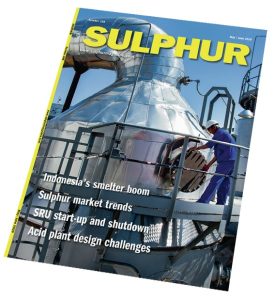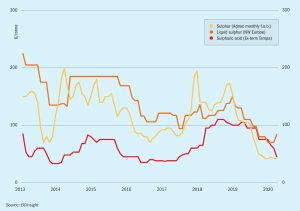
Innovation showcase
We profile a selection of innovative speciality products and agronomic technologies that have recently been brought to market.

We profile a selection of innovative speciality products and agronomic technologies that have recently been brought to market.

As the industrial value chain for fertilizers and their raw materials manages its way through the unprecedented global Covid-19 pandemic, Metso Outotec’s Hannes Storch, Collin Bartlett & Marcus Runkel reflect on the range of digital tools installed by the company at its industrial reference plants globally.

The phosphates market to date has remained remarkably resilient during the Covid-19 pandemic. Despite early fears, 2020 has seen strong overall demand so far and no major supply-side disruptions. But concerns still lie ahead, as Alberto Persona , principal phosphate analyst at Fertecon/IHS Markit, explains.

Sulphur is becoming an increasingly important crop nutrient – due to a combination of lower sulphur emissions, the increasing prevalence of high-analysis fertilizers and higher cropping intensity.

Meena Chauhan, Head of Sulphur and Sulphuric Acid Research, Argus Media, assesses price trends and the market outlook for sulphur.

Ordinarily I try to choose a different subject each issue for an editorial, but as April lengthens towards May, and here in the northern hemisphere we start to see the first signs of summer, there unfortunately remains only one subject that is obsessing every industry, and that is the Covid-19 pandemic and its impact upon every aspect of our lives. Since our last issue we have all had to come to terms with ‘lockdown’ and ‘social distancing’, as the grim toll of deaths climbs in all regions. Here at BCInsight we are working without an office as best we can, and issues of Sulphur will continue to land in your email inboxes, but paper copies of the magazines may take longer to arrive, if at all, as shipping and customs procedures are tightened all around the world, and I can only apologise and ask that you bear with us.

How the macro market responds to the coronavirus pandemic over the months ahead and governmental response in different parts of the globe will likely have a lasting impact on the outlook for the sulphur market.

West Texas Intermediate (WTI) forward oil prices for May dropped into negative territory during mid-April, on fears of lack of storage capacity to deal with the excess production. Forward prices for June were also nosing to equally unprecedentedly low levels.Elsewhere, Brent Crude spot prices dropped to $20/bbl, a fall of $50/bbl from the start of 2020.

Sulphur’s annual survey of recent, current and future sulphur recovery unit construction projects maps the developing shape of brimstone production from fuel and gas processing plants worldwide.

BASF has developed a new generation of promoter system compatible with MDEA solutions named OASE® yellow. The new promoter system increases the selectivity and capacity of the amine solvent, resulting in improved performance of tail gas treating units and allowing the processing of more sour crudes. A. Kern and G. Vorberg of BASF discuss two case studies demonstrating the benefits of OASE yellow.